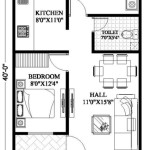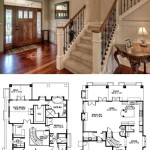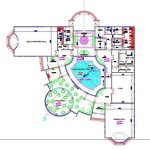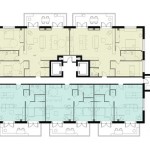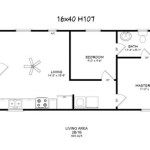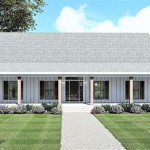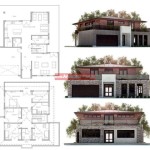Architecture Plan For House: A Comprehensive Guide
An architectural plan for a house serves as the blueprint for its construction. It is a detailed technical drawing that outlines the design, layout, and specifications of a residential building. These plans are essential for obtaining building permits, securing financing, and guiding the construction process. They provide a visual representation of the finished product, allowing all involved parties, from architects and builders to homeowners, to understand the project's scope and details.
Architectural plans comprise several key elements, each serving a specific purpose. Floor plans are a fundamental component, depicting the layout of each level of the house. They show the arrangement of rooms, walls, windows, doors, and staircases. Elevations offer a two-dimensional view of the exterior walls of the house from different angles, illustrating the heights of windows, doors, and rooflines. Sections provide cutaway views of the house, revealing the internal structure and detailing the construction methods for walls, floors, and roofs.
Site plans depict the location of the house on the property. This includes boundaries, topography, landscaping, and the positioning of utilities. Site plans are crucial for understanding the relationship of the house to its surroundings and ensuring compliance with local building codes and zoning regulations. Foundation plans detail the structural support system for the house, including the type of foundation, footings, and supporting walls. These plans are critical for ensuring the stability and longevity of the structure.
Roof plans illustrate the layout and design of the roof, including the slope, materials, and drainage systems. These plans are essential for ensuring proper water runoff and preventing leaks. Detailed drawings provide specific information about various building components, such as doors, windows, cabinetry, and stairways. These drawings specify dimensions, materials, and construction techniques, ensuring consistent quality and adherence to the design intent.
The process of developing an architectural plan begins with a thorough assessment of the client's needs and desires. This involves discussions about lifestyle, budget, and desired aesthetic. The architect then translates these requirements into a preliminary design, which is presented to the client for review and feedback. This iterative process allows for refinement and adjustments until a final design is approved.
Once the design is finalized, the architect prepares the detailed construction drawings. These drawings include all the necessary information for obtaining building permits and guiding the construction process. They provide precise measurements, material specifications, and construction details for every aspect of the project.
The choice of architectural style significantly impacts the design and layout of the house. From traditional styles like Victorian, Colonial, and Craftsman to modern and contemporary designs, each style offers a unique aesthetic and functional approach. The architectural style influences the choice of materials, the arrangement of spaces, and the overall character of the house.
Sustainable design principles are increasingly incorporated into architectural plans. These principles prioritize energy efficiency, resource conservation, and environmental responsibility. Sustainable design features can include passive solar heating and cooling, rainwater harvesting, and the use of eco-friendly building materials. The integration of these features can reduce the environmental impact of the building and contribute to lower operating costs.
Technology plays a crucial role in modern architectural planning. Computer-aided design (CAD) software enables architects to create detailed and accurate drawings with ease. Building Information Modeling (BIM) software takes this further, creating a 3D model of the building that incorporates all design and construction data. These technologies streamline the design process, enhance collaboration, and facilitate more accurate cost estimation.
Working with a qualified architect is essential for the successful execution of an architectural plan. Architects possess the technical expertise and creative vision to translate client needs into functional and aesthetically pleasing designs. They also navigate the complexities of building codes, zoning regulations, and permit applications. Their involvement ensures that the project adheres to professional standards and meets all legal requirements.
The budget for an architectural plan varies depending on the size and complexity of the project, the architect's fees, and the location. Obtaining multiple quotes from different architects is advisable to compare pricing and services. A well-defined budget from the outset helps to ensure that the project stays on track and within financial constraints.
Proper communication and collaboration between the architect, client, and builder are vital throughout the project lifecycle. Regular meetings and clear communication channels ensure that everyone is on the same page and that any issues are addressed promptly. This collaborative approach minimizes misunderstandings and contributes to a successful outcome.
Building codes and regulations play a critical role in architectural planning. These codes dictate minimum standards for construction, ensuring safety and structural integrity. Compliance with these codes is mandatory and is verified through the permit application process. Architects are well-versed in building codes and ensure that the designs comply with all relevant regulations.

House Plans Home Floor Architecturalhouseplans Com

House Plans How To Design Your Home Plan

Floor Plans Learn How To Design And Plan

Floor Plan Wikipedia

Plan 4525 Design Studio Architectural House Plans Floor Dream

Architectural House Plans Custom Home Plan Structural

A Vaastu Home With Its Modern Traditional Elements Studio Imagine The Architects Diary Design Floor Plans House Layout Architectural

Importance Of House Floor Plans In Architectural Design

House Plans How To Design Your Home Plan

How To Build A House From Paper Plaster Architectural Digest

